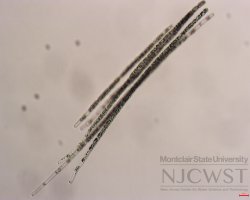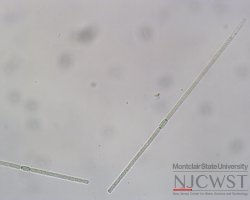Taxonomy
- Order
- Nostocales
- Family
- Aphanizomenonaceae
- Genus
- Aphanizomenon
Examples of Aphanizomenon
Morphology
Trichomes are often gathered into fasciculated colonies of roughly parallelly arranged trichomes (first two images to the right); these bundles may be macroscopic and look like flakes, or like “grass clippings” floating on the surface of waterbodies; trichomes are also sometimes solitary. Trichomes isopolar; straight to slightly curved; unconstricted to slightly constricted at crosswalls, rarely deeply constricted; may or may not be slightly narrowed towards the ends. Without firm sheaths; sometimes with fine, diffuse mucilaginous envelopes. Cells cylindrical or sometimes long barrel-shaped; with aerotopes; pale blue-green. End cells typically elongated and hyaline (clear); terminal cells flattened to rounded.
Heterocytes intercalary and solitary; usually cylindrical, rarely oval, as wide as vegetative cells; rarely with more than 3 heterocytes per trichome (usually with just 1). Akinetes usually cylindrical (roughly oval in a couple species); intercalary; solitary or in rows of 2-3; developing paraheterocytically; close to or distant from heterocytes.
Compare to Cuspidothrix, which was separated from Aphanizomenon; trichomes of Cuspidothrix are distinctly narrowed and pointed at the ends.
Ecology
Planktic; common bloom-former in temperate regions.
References
- Johansen, J. R., & Komárek, J. (2015). Filamentous Cyanobacteria. In J. D. Wehr, R. G. Sheath, & J. P. Kociolek (Eds.), Freshwater Algae of North America: Ecology and Classification (2nd ed., pp. 183-212). Waltham, MA: Elsevier.
- Komárek, J. (2013). Cyanoprokaryota-3. Teil/Part 3: Heterocytous Genera (J. R. Johansen, Ed.). In B. Büdel, G. Gärtner, L. Krienitz, & M. Schagerl (Eds.), Süßwasserflora von Mitteleuropa (Vol. 19/3, pp. 664-686). Heidelberg, Germany: Springer Spektrum.



